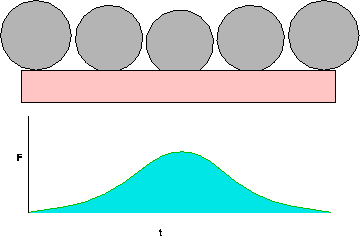
Suppose we look at a superball hitting a hard table with some high speed camera. What will we see? Well, we'll see the ball getting kind of smushed against the table. The more smushed, the greater the force the table exerts on the ball. So like a brontosaurus, the normal force of the table starts off small gets bigger, and then gets smaller again.
So the external force acting on the superball, namely the normal force of the table is some function of time pictured below.
Now how do we relate this to the momentum? Let's use eqn. 1.12.
![]()
The time
derivative of the momentum of the ball ![]() is
equal to the normal force of the table
is
equal to the normal force of the table ![]()
So as you can think of this as saying that normal force of the table is decelerating thethe ball, causing it to slow down, so the momentum decreases. Eventually the ball completely changes direction because the force continues to act on the ball even after it has become maximally squashed. So the ball reaccelerates away from the wall until it looses contact with the table.
So if the normal force is responsible for the change in momentum, how is the total change in momentum related to this force?
Well we just integrate eqn. 1.12 from the
initial time of contact ![]() to the final time of
contact
to the final time of
contact ![]() . This gives an expression for the change
in momentum
. This gives an expression for the change
in momentum
![]()
This is just the area under the force curve pictured in figure
1.4.1. We can get an idea of the magnitude of
the force by calculating the forced averaged over the interval
from ![]() to
to ![]() .
.
![]()
From the last equation this means
![]()
OK, the derivation of this seemed like a lot of work, but the final result is quite interesting. The average force felt during a collision is the ratio of the change in momentum to the change in time.
So what happens if a collision is really fast? The average force during that time will be really large. Let's think about this in everyday life. When you drop a glass on a tile surface it breaks, where as on a shag carpet it won't even chip. What's the difference? About $10 if was a fancy glass like the kind my mom likes to keep around (but never uses except for when they have ``sophisticated" company). But seriously, the difference is that the carpet ``gives" more than the rug. It's softer. This means that the collision last a lot longer than on tile. So the average force will be quite a bit large, causing the glass to break.
With a lot of collisions, baseballs against bats, pool balls against
each other, glass against tile, and countless other situations,
the time of the collision is very short, of order milliseconds
and the change in momentum is quite large. In this case you get
quite humongous forces during a collisions. Let's do an estimate.
Assume a time of contact of ![]() a mass of 1kg, and
a change in velocity of 1m/s. You get an average force of
a mass of 1kg, and
a change in velocity of 1m/s. You get an average force of
![]() which is
which is ![]() . The weight of
a 1kg mass is about 10N, so that the force during the
collision is 100 times greater than the force of gravity. No
wonder people try to avoid getting hit by baseball bats, they
can pack quite a punch!
. The weight of
a 1kg mass is about 10N, so that the force during the
collision is 100 times greater than the force of gravity. No
wonder people try to avoid getting hit by baseball bats, they
can pack quite a punch!
What that means is that during one of these fast collisions, you can ignore the effect of gravity, friction, springs, or any other force acting. The collisional force will exceed these other forces.
With this in mind, let's discuss collisions one dimensional collisions in more detail.